2015 in retrospect
The winter solstice seems like a good time to look back over the 2015 beekeeping year. With the day length about to start increasing, what went right and what went wrong? Back in March I wrote that my plans for the year were different from the usual OSR – swarming – queen rearing – summer flow – harvest – Varroa treatment – feed-’em-up and forget ’em routine as I was moving to Scotland in the middle of the season. Some of these things happened, though perhaps less than in a usual year.
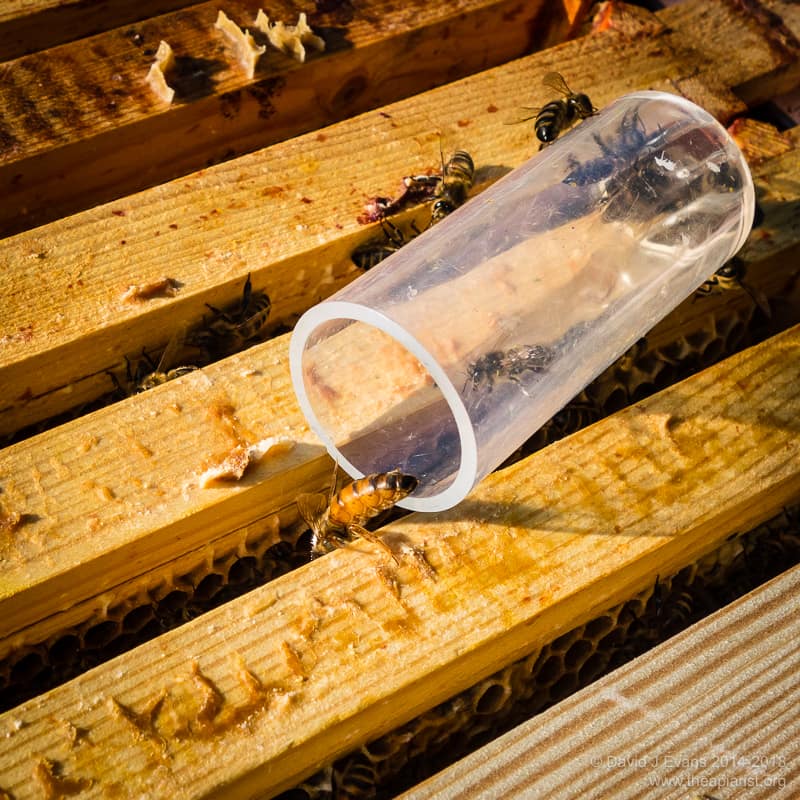
Mid-season memories …
Spring – better late than never
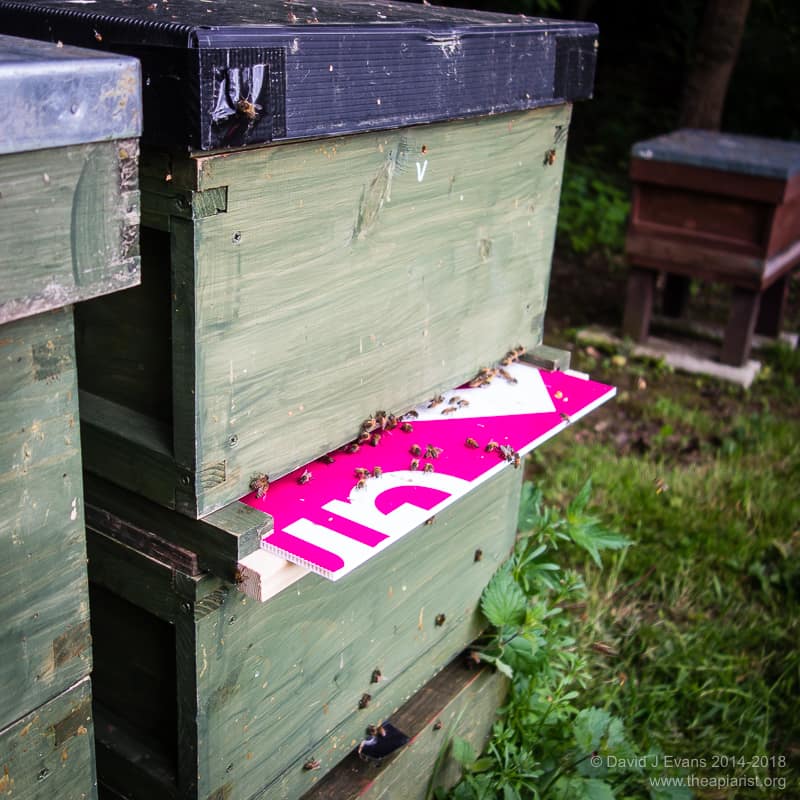
Cloake board …
The OSR yielded poorly as the spring was cold and late. I didn’t even look inside a colony until mid-April. Colonies were only getting strong as the OSR flowers went over meaning that most of it was missed. The weather was unseasonably cold, with mid-May being 2-3ºC cooler than average. Queen rearing started in the third week of May and although grafting went well, queen mating was really hit and miss, with low temperatures and lots of rain lasting through May and June. On a more positive note, I used a Cloake board for the first time and was pleased with the results (I’ll write about this sometime in 2016 after using it a bit more). I didn’t use any mini-nucs this year as I didn’t want the hassle of dealing with them mid-season when moving North. Instead, I did all of my queen mating in 2-5 frame nucs, often produced as circle splits from the cell-raising colonies. This worked well … and considering the lousy weather was probably a lot less effort than using mini-nucs which would have required constant attention and lots of feeding. Using poly-nucs I could prime them with a frame of brood and a frame of stores and adhering bees, dummy them down and leave 3 frames of foundation (or wherever possible, drawn comb) ready to be used on the other side of the dummy board. Once the queen was mated the colony would build up well and if – as often happened this season – the queen failed to get mated or was lost (drowned?) during mating flights it was easy to unite the queenless unit with a queenright one, so not wasting any resources.
Go forth and multiply
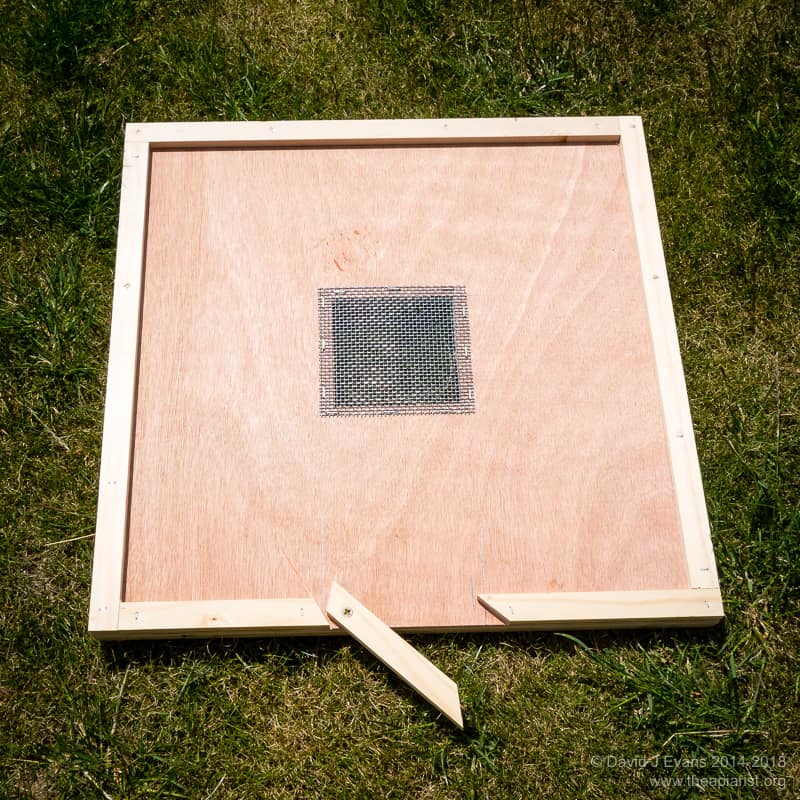
Split board …
Beginners often find the coordination of colonies for queen rearing, and the apparent difficulty of grafting (it isn’t), a daunting prospect. When I’ve been involved in teaching queen rearing it’s clear that the relatively small scale approach I use (queenright cell raiser, grafting and – usually – mini-nucs) is often still too involved for the very small numbers of queens most beekeepers with just a couple of hives want. It was therefore interesting to raise a few queens using vertical splits, simply by dividing a strong colony vertically and letting the bees do all the work of selecting the best larvae, raising the queen and getting her mated. It has the advantage of needing almost no additional equipment and only requires a single manipulation of the hive (and even that can probably be simplified). Having documented the process this season I’ve got a few additional things I’d like to try in 2016 to make it even easier and to allow better stock selection. After that it will be incorporated into queen rearing talks and training.
Changes in Varroa treatment
The big change in Varroa treatment in the UK was the licensing of Api-Bioxal. Whether or not you consider the 50-fold or more cost of VMD-approved oxalic acid (OA) over the generic powder is justified is really a separate issue. Oxalic acid is an effective miticide and, if administered appropriately, is very well tolerated by the colony. Despite the eyewatering markup, Api-Bioxal is significantly less expensive than all other approved miticides. For the small scale beekeeper it’s probably only 20% the cost of the – often ineffective – Apistan, or either Apiguard or MAQS. Under certain circumstances – resistant mites, low temperatures or the potential for queen loss – there are compelling reasons why OA is preferable to these treatments. If we hadn’t been using OA for years the online forums would be full of beekeepers praising the aggressive pricing strategy of Chemicals Liaf s.p.a in undercutting the competition. Of course, if we hadn’t been using generic OA for years Api-Bioxal would probably be priced similarly to Apiguard 🙁
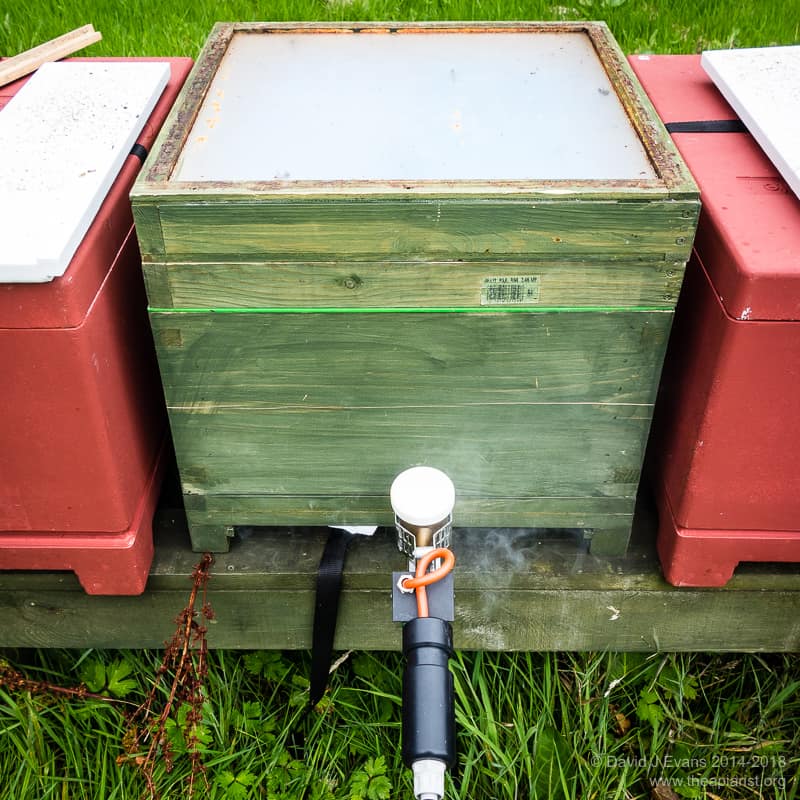
Sublimox in use …
I’ve used OA sublimation throughout 2015 and been extremely impressed with how effective it has been. Mite drops in colonies treated early in the season remained low, but increased significantly in adjacent colonies that were not treated. I treated all swarms caught or attracted to bait hives. Some were casts and there were no problems with the queen getting out and mated (though the numbers of these were small, so statistically irrelevant). Late season treatment of colonies with brood also seems to have worked well. Mite drops were low to non-existent in most colonies being monitored through late autumn. Colonies get mildly agitated during treatment with a few bees flying about under the perspex crownboard (you can see a couple in the image above … this was a busy colony) and a few more rapidly exiting the hive after the entrance block is removed. But that’s it. The colony settles within a very short time. I’ve seen no loss of brood, no obvious interruption of laying by the queen and no long-term detrimental effects. Sublimation or vaporisation of OA can – with the correct equipment – be achieved without opening the hive. I expect to use this approach almost exclusively in the future.
Moving bees
Moving colonies from the Midlands to Fife was very straightforward. Insect netting was an inexpensive alternative to building large numbers of travel screens. It’s the same stuff as Thorne’s sell for harvesting propolis so I’ve got enough now to go into large scale propolis production 😉 The colonies all settled in their temporary apiaries well and I even managed a few supers of honey during the latter part of the season.
Small hive beetle reappeared in Southern Italy shortly after the honey harvest was completed there. Che sorpresa. This was disappointing but not unexpected (and actually predicted by some epidemiologists). As I write these notes the beetle had been found in 29 Calabrian apiaries between mid-september and early December. It’s notable that there’s now a defeatist attitude by some contributors to the online forums (when not if the beetle arrives here) and – since not everyone are what they seem on the interweb – there are some playing down the likely impact of the beetles’ arrival (and hence the demand to ban imports) because they have a vested interest in selling early season queens or nucs, either shipped in or headed by imported queens. I don’t think there’s any sensible disagreement that we would be better off – from a beekeeping perspective – without the beetle, it’s just that banning imports of bees to the UK (admittedly only a partial solution) is likely to cause problems for many beekeepers, not just those with direct commercial interests. I remain convinced that, with suitable training and a little effort, UK beekeeping could be far less dependent on imports … and so less at risk from the pathogens, like small hive beetle. Or of course a host of un-tested for viruses, that are imported with them.
And on a brighter note …
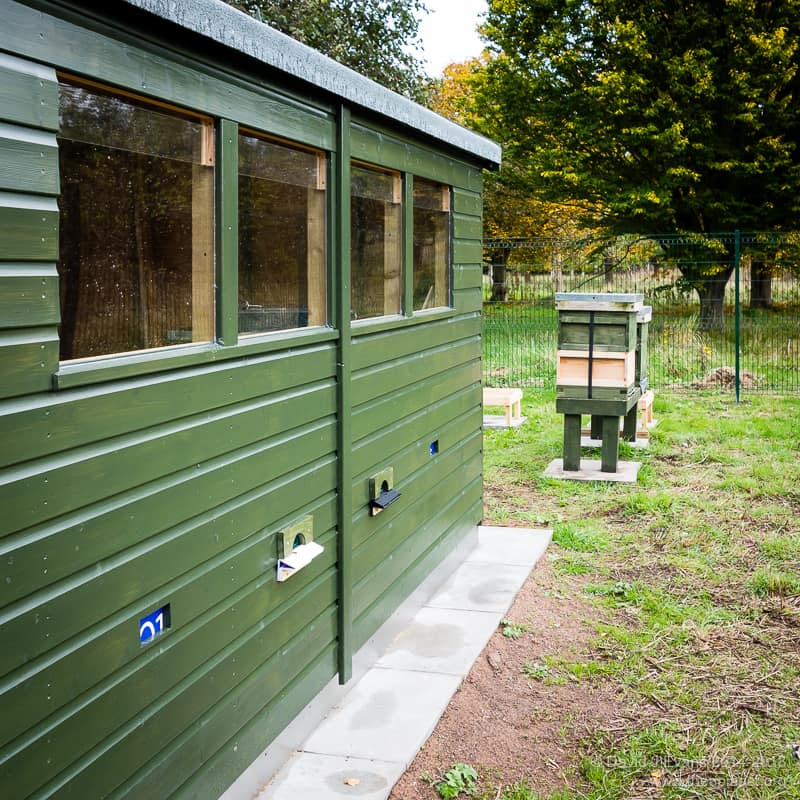
Bee shed …
The new development in the latter part of the year was the setting up of a bee shed to house a few colonies for research. This is now more or less completed and the bees installed. It will be interesting to see how the colonies come through the winter and build up in spring. The apiary has colonies headed by sister queens both in and outside the bee shed so I’ll be able to make some very unscientific comparisons of performance. The only problem I’ve so far encountered with the shed was during the winter mite treatment by oxalic acid vaporisation. In the open apiary the small amount of vapour that escapes the sealed hive drifts away on the breeze. In the shed it builds up into a dense acidic hazy smoke that forced me to make a rapid exit. I was wearing all-encompassing goggles and a safety mask so suffered no ill effects but I’ll need an alternative strategy for the future.
Due to work commitments, house, office and lab moves, things were a lot quieter on the DIY front this year. The Correx roofs have been excellent – the oldest were built over a year ago and are looking as good (or as bad, depending on your viewpoint) as they did then. They’ve doubled up as trays to carry dripping supers back from the apiary and I’ll be making more to cover stacks of stored equipment in the future. Correx offcuts were pressed into service as floors on bait hives, all of which were successful.
With well-fed colonies, low mite counts, secure apiaries and lots of plans for 2016 it’s time to make another batch of honey fudge, to nervously (it’s got hints of an industrial cleaning solution) try a glass of mead and to finish labelling jarred honey for friends and family.
Happy Christmas

Lomond Hills and OSR
Join the discussion ...